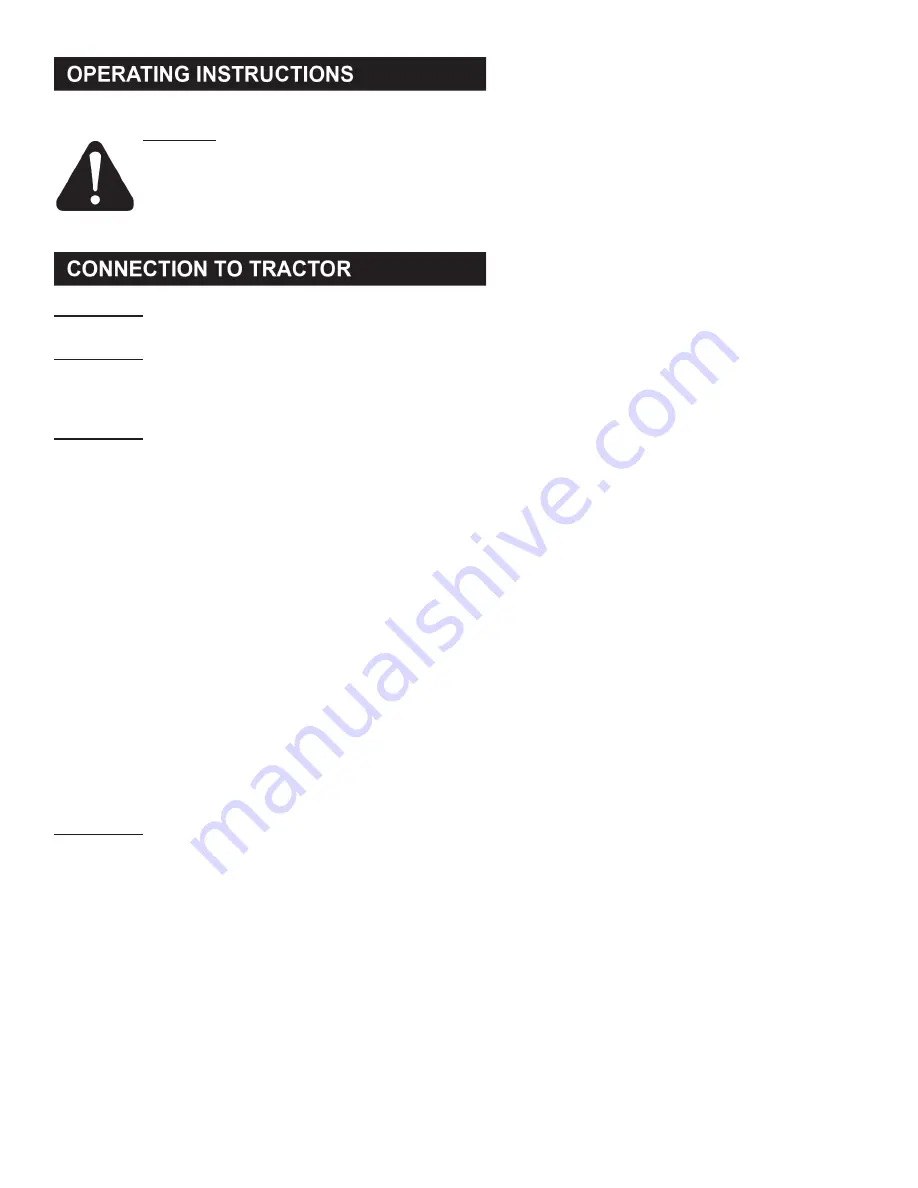
Page 10
IMPORTANT:
The tractor must be able to handle Category I or Category II three-point hitch implements and be
equipped with a four-way valve (for double-acting cylinders) and hydraulic outlets.
IMPORTANT:
This splitter comes equipped with a hydraulic valve compatible with open center hydraulic systems.
Check the hydraulic system on your tractor. For closed center systems, you will need to install the
closed center spool conversion kit 582328 provided with the splitter. Instructions are included in the kit
for converting the valve from open center to closed center.
IMPORTANT:
Consult your tractor owner’s manual for instructions on tractor operations, auxiliary hydraulics, return
flow hookups and safety.
NOTE: Hoses to the tractor are not included.
Specifications of the hoses and fittings supplied by the owner should
be within recommended ranges of the tractor operating pressure.
1.
Back tractor into position and slide the lift arms over the draw pins on the frame assembly (item 2 from Frame
Assembly Breakdown, pg 12). Secure the tractor lift arms to the splitter frame draw pins (S07020800) using lynch
pins (not provided). Attach the top link from the tractor to the mast plates on the top of the splitter frame and secure
with top link pin (S071022WC) and lynch pin (S07090400).
2.
Locate the pressure and return ports on the rear of the tractor.
3.
Connect the hoses from the tractor to the log splitter with the flow from the pressure port entering on the “IN” side
of the valve. The return flow to the tractor should attach to the “OUT” side of the valve.
4.
After connecting the hoses, activate the tractor auxiliary valve to provide hydraulic power to the splitter. If the
hydraulic system is operating normally, secure tractor auxiliary valve in the “ON” position. Next, activate the log
splitter valve lever and confirm the wedge moves in the direction specified in the instructions on the cylinder. If the
wedge is not moving in correct direction, the tractor auxiliary valve can be reversed or the hoses can be reversed in
the tractor ports.
5.
The tractor hydraulic system must be capable of delivering 6 to 20 GPM of oil at 1500 to 2500 PSI for adequate
splitting force and speed. The tractor should have a hydraulic oil cooling system to allow semi-continuous
operation.
IMPORTANT:
If the tractor engine pulls down or if the hydraulic oil is heard going over relief, return the lever to the neu
-
tral position and check all hoses, fittings, and connections. If the splitter is used with the flow reversed
(wedge traveling opposite the direction of the valve handle) the relief valve will not work and could result
in damage to the tractor or the log splitter.
6.
Using the tractor three-point hitch, raise the log splitter to a convenient height and level with the top link. The log
splitter may be operated in either the horizontal and vertical position. See illustration on page 5.
7.
To deploy rear stand:
a)
At rear work extension stand, remove pivot lock pin and pivot stand down to the vertical position. Reinstall pivot
lock pin.
b)
Remove extension lock pin and slide lower leg of stand down until it touches the ground. Reinstall lock pin in
one of the three holes that best lines up with inner stand hole.
WARNING: Read and thoroughly understand all instructions in this manual and on safety decals
before assembling or operating this log splitter. Failure to do so may cause serious injury or
death. Do not allow anyone to operate this log splitter who has not read this manual. As with all
power equipment, a log splitter can be dangerous if assembled or used improperly. Do not
operate this log splitter if you have any questions concerning safe operation. To get answers to
any questions, call our technical support department at 1-800-319-6637.





























